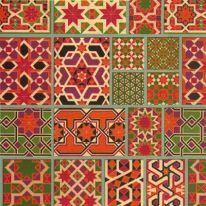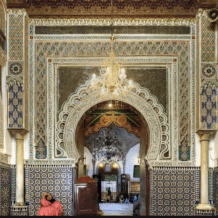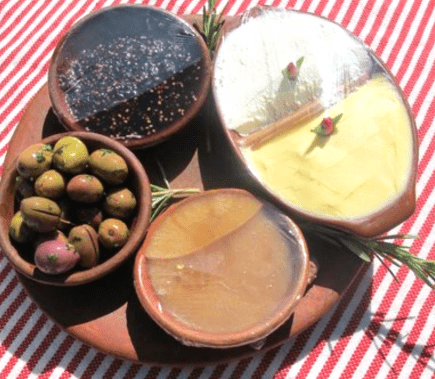
Jben, the Northern Moroccan Cheese, Originates from Blue Pearl Chefchaouen
Chefchaouen is a town nestled in Morocco’s northern Rif Mountains. often referred to as the “Blue Pearl” for its idyllic blue-painted houses and cobblestone alleys. Surrounded by protective peaks that resemble ram horns. the name “Chefchaouen” refers to the shapes of the mountain tops that look like the two horns (chaoua) of a goat. “Chef Chaouen” means “look at the horns”. It’s also known for its leather and weaving workshops yet most of all spoken about in cuisine circles for the historic, homemade goat cheese that it produces called Jben.
The rounded traditional cheese, Jben, is emblematic of the Chefchaoun territory and a stable in northern Moroccan regional cuisine. Jben is made from fresh goats milk and sometimes mixed with cow dairy. Cheese connoisseurs are typically impressed with Jben’s unique taste and the traditional production process of how it is made.
To enrich your Jben cheese tasting experience while traveling in Chefchaouen, our friendly guide provides the most frequently asked questions about Jben cheese.
What is Jben?
Jben is a traditional Moroccan goat cheese made from pure goat milk or cow-goat milk. It is considered a healthy cheese and often served at Moroccan breakfast tables because it is both easy to digest and can be paired with various types of Moroccan bread. It is also eaten during ftour (the break fast) during Ramadan.
The milk used in making Jben is unpasteurized and from a natural rennet. This will either come from a fig sap or from a young goat’s stomach. It is usually pressed and wrapped into a palm leaf, then sold on the streets and in local Moroccan markets. The flavor is natural, often pungent, and can be eaten salted or unsalted. Sometimes herbs are added. The texture ranges from smooth and fluffy to hard and crumbly. It can be moist or dry.
How is Jben different from regular goat cheese?
Morocco places a special emphasis on breeding goats. This makes the cheese particularly fresh and flavorful. The goats that produce the Jben are fed in natural pasture environments and graze on local herbs and plants from the mountainside. The milk used for Jben is fermented and salt is added to preserve it. Jben can last longer than the common goat cheese found in regular grocery stores. Some Jben cheese can last up to 30 days.
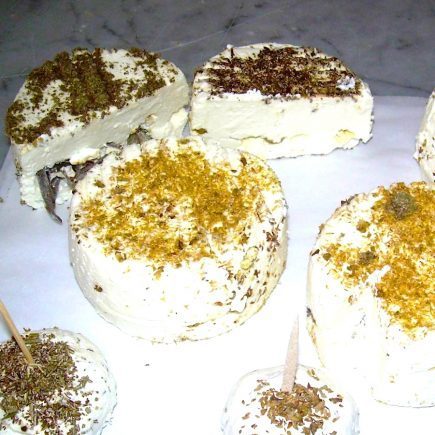
How is Jben eaten?
Northern Moroccans say that Jben is a breakfast must. Jben is often served sprinkled with olive oil, thyme, and herbs and served alongside Moroccan breakfast staples such as freshly baked bread or msemen (pancakes), black olives, mint tea, and orange juice. Depending on the texture, Jben can be spread or sliced onto bread. Sometimes it is added to omelets or used as a stuffing for briouats (fried Moroccan spring rolls).
How is Jben produced? Cheese lovers are often astonished to learn that Jben is quick and easy to make. It can be made in 15 minutes and ready to eat in as little as 10 hours. As a result, it can be found in most Northern Moroccan households. It is mainly produced by families so the quantity available is less than other Moroccan cheeses.

Where to buy Jben?
A few times a week, female farmers wearing large handmade straw hats from the Rif Mountains make the trek from the countryside to Chefchaouen. They set up elegant displays of white creamy and round Jben cheeses along its blue maze-like streets. The cost of Jben is inexpensive as a whole disc is available for under a few dollars. Jben is also sold in many local cafes, markets, and kiosks throughout the Rif mountains and in the Tangier-Tetouan region. An adventure to the Rif Mountains is a one-of-a-kind experience. Most farmers and shop owners do not speak English and this lends an opportunity to learn some words in Moroccan Arabic to navigate your own local journey of purchasing Jben and other local fresh made items in the marketplace. Jben is also sold in cities like Fes or Casablanca, however, it is primarily associated with the Tangier-Tetouan region.
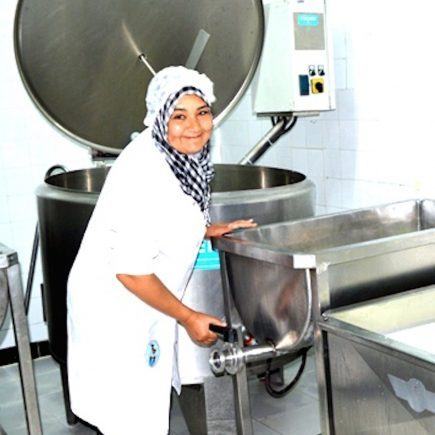
Where can I visit a cheese factory in Chefchaouen?
Ajbane Chefchaouen is the most trusted one in the region. The creamery was founded in 1992 and is run by Zineb Errati. It has 6 employees and strives to guarantee high-quality products. It produces a wide range of dairy products such as fresh and semi-cured cheeses, gouda, and yogurt for various markets. These items have a quality label awarded by the Sheep and Goat National Association (ANOC). The non-profit organization was created in 1967. Its members are evaluated for quality products and following a clean process. The award labels were aimed to help consumers know that what they are buying is safe.
Ajbane Chefchaouen purchases milk from 60 local goat breeders selected for their exceptional mixed breed or alpine races. Although this particular goat can only produce 2 liters of milk per day, the herds feed off the Rif Mountains; as a result, the milk has a rich fat and protein content.
While there are six other cheese factories in Chefchaouen, Ajbane is the only one recognized by ANOC. Ajbane transforms 200,000 liters of milk per year, thanks to a network of 40 herds and 1,800 goats. Its products can be found in several cities such as Chefchaouen, Tetouan, Tangier, Rabat, and Casablanca. The organization is part of a public-private partnership.
Ajbane is located on Road Tétouan – Ouezzane, Km 60 – Douar: Amlay- Rural Municipality: in Bab Taza, within the Province of Chefchaouen.
How are goats bred in Morocco?
Goat breeds are divided into caprine and ovine. Between the two categories, there are nearly two dozen different kinds of goats. The Beni Arous goat is typical of Chefhaouen and the Rif area.
What do goats eat? Goats are fed from pastoral and farm resources. When the weather limits this grazing, forages, fallows, straws, and cereal stubble supplement the goat’s nutrition. *
How are goats treated in Morocco?
The Morocco Green Plan has created incentives for farmers to implement. These measures are intended to help protect the different populations of goat breeds in Morocco. Particularly, the Rahali in the Anti Atlas and the Laghzalia in the north constitute an important genetic diversity that is in need of protection.
What is the role of goat farming in Morocco’s agricultural economy?
As a result of severe drought over the past decades and the interest in more profitable farming activities and the number of goats has decreased. In the 1970s, 8 million goats were counted. According to ANOC, there are now an estimated 6.2 million goats counted for 2018. Moroccan goats produce a national average of 57 million liters of milk and 25,000 metric tons of meat per year. Compared to the national average for each category, this is 3% and 5%. Despite these low levels of production, goat farming plays an essential role in the population of mountainous areas. Goats also play a major role in providing protein and income for the local rural populations.
* Data for this article was collected from an article written by Mouad Chentouf, IGA Regional Director for North Africa.

